Smoking imparts a depth of flavor and texture to meat that is difficult to achieve with other cooking methods.
The long and slow process of smoking, at relatively lower heat compared to grilling, creates an environment that allows meat to baste in its own juices and, coupled with the flavors that the wood imparts, results in deliciously delicate yet deep-flavored meat that isn’t overly charred.
It may be intimidating to even attempt it if you’re new to the whole business of smoking meat, but there are actually beginner-friendly meats you can start with and learn from.
Reading all the books and recipes about smoking will surely help you get started, but applying what you learned, with a forgiving meat cut to start with, will help you learn much faster, and help you get a heads up on the tougher cuts to work with.
21 Easiest Meats to Smoke for Beginners
- Whole Chicken
- Chicken Legs or Thighs
- Chicken Wings
- Chicken Breast
- Sausage
- Burgers
- Ham
- Breakfast Fatty
- Pork Butt or Pork Shoulder
- Pork Belly / Bacon
- Pork Loin
- Turkey Breast
- Turkey Legs
- Salmon
- Shrimp
- Lamb Shoulder
- Tri Tip
- Rib Eye Steak
- Beef Ribs
- Short Ribs
- Chuck Roast
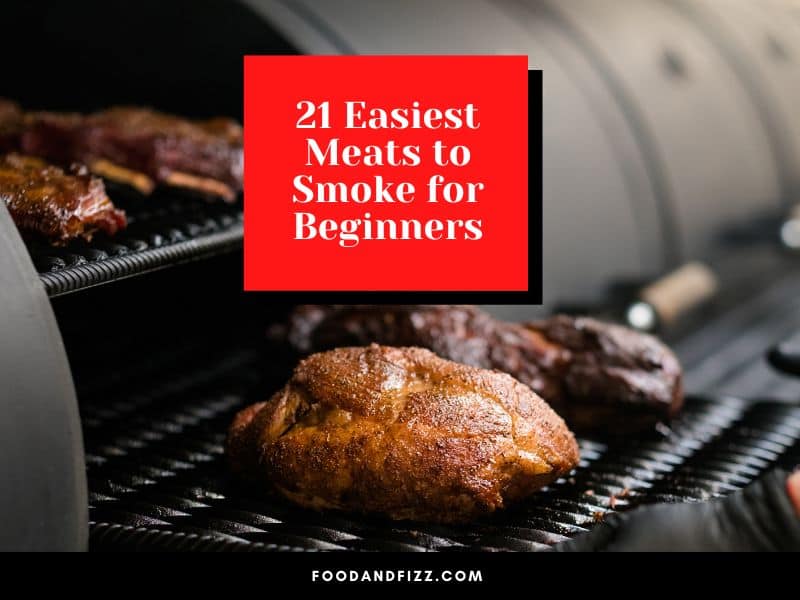
Easiest Types Of Meat For Smoking Video
21 Easiest Meats to Smoke for Beginners
It’s like riding a bike. You start off with training wheels first until you get the hang of this whole balancing on two wheels thing. Once you’ve figured out the basics and have gotten the hang of it, you can pretty much do whatever you want.
It’s the same with any skill, including smoking meat. It is important to start with the basics first, with simple and more forgiving cuts of meat, before working your way up to the bigger, more complex cuts.
In this section, we’ll look at some of the best meats to smoke if you’re a beginner.
1. Whole Chicken
Whole chicken is a beginner-friendly meat to smoke since it is affordable, difficult to mess up, and simple to source. Unlike other types of meat where grades and ratings may be confusing, chicken is pretty straightforward to buy.
Granted, that crispy skin may not be achieved entirely with smoking but when done right, your meat will for sure be tender and flavorful. You can choose to season your chicken with just salt and pepper or use your desired spice rub.
- Recommended Smoker Temperature: 275°F – 350°F
- Finished Temperature: 170°F
- Smoking Time: 2-3 hours
- Tips for Success: Wet brining your chicken will allow it to retain moisture, especially for the breast part that can dry up too fast

2. Chicken Legs or Thighs
Chicken legs or thighs are inexpensive, simple, easy to prepare, and can easily feed a big group of people. It is easy to source and doesn’t take long to smoke. You can serve it as is or make something like pulled chicken sandwich.
- Recommended Smoker Temperature: 275°F – 350°F
- Finished Temperature: 170 °F
- Smoking Time: 1 ½ to 2 hours
- Tips for Success: Cook them bone in and skin on, for extra fat and flavor

3. Chicken Wings
Who doesn’t love chicken wings? This versatile meat cut does well with a variety of cooking styles like deep frying, roasting, grilling, and baking, so it’s no surprise that it is also delicious when smoked.
When smoked, chicken wings have a texture and flavor similar to other bigger pieces of meat that are more popularly smoked, but it comes in small, finger-food portions which makes it extremely convenient to serve.
- Recommended Smoker Temperature: 275°F – 350°F
- Finished Temperature: 170 °F
- Smoking Time: 1 ¼ – 1 ½ hours
- Tips for Success: Add some corn starch into your rub to make the skin crispy, or once the chicken reaches safe doneness, broil in the oven for a few minutes to get that crispy skin.
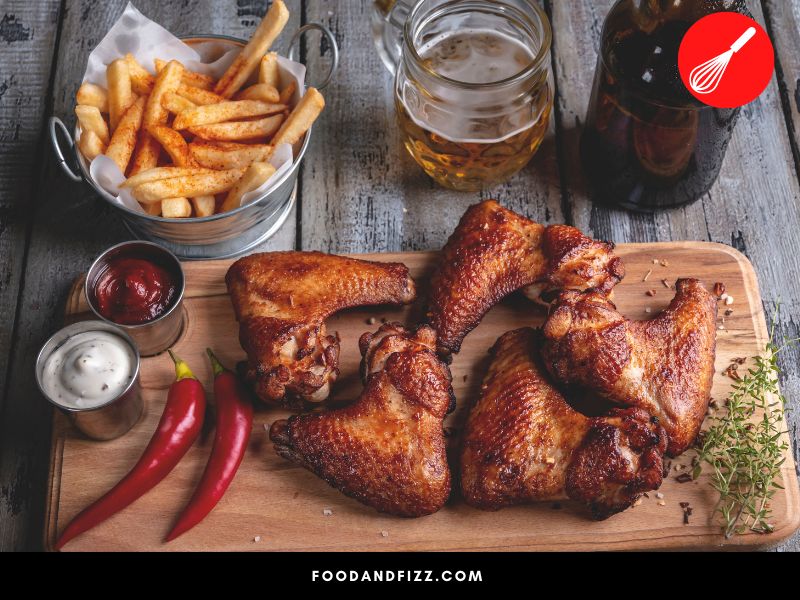
4. Chicken Breast
Chicken breast does have the tendency to dry out since it doesn’t contain a lot of fat, so a lot of people will say to not even bother smoking chicken breasts. However, it is not impossible as long as you keep a close watch on it and if you take some extra precautions to ensure it doesn’t overcook and dry out.
“Low and slow” is the key to smoking chicken breasts, so cooking at lower temperatures for a longer period of time ensures tender and juicier meat. Brining beforehand will also help retain more moisture, as well as coating the chicken breast with some olive oil or fat to help your seasonings stick.
- Recommended Smoker Temperature: 275°F – 350°F
- Finished Temperature: 170 °F
- Smoking Time: 1 to 2 hours
- Tips for Success: Brine chicken or rub it with some olive oil or fat to help some of the seasonings stick and provide an extra layer of fat and flavor.
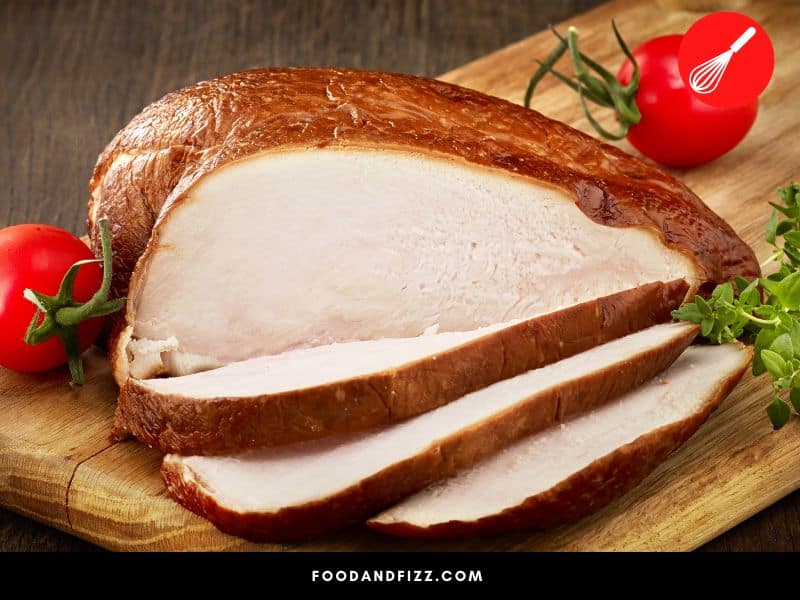
5. Sausage
Sausages have a short smoking time and are very beginner-friendly. Plus, with the endless varieties available, they can quickly elevate the flavors and textures of your menu without much effort on your part.
You can even serve them as appetizers prior to your main meal. Also, with a lot of varieties of sausage also being cured and ready to eat, it is a safe way to experiment with getting a smoky flavor on meat without worrying too much about temperature safety.
- Recommended Smoker Temperature: 225 °F – 250 °F
- Finished Temperature: 160°F for beef and pork sausage, 165°F for poultry
- Smoking Time: 30 minutes to 1 hour
- Tips for Success: Do not make slits on the sausage as this might cause the sausage to dry out more easily.Buying cured and ready-to-eat varieties will also help you practice your smoking skills without necessarily worrying about safe internal temperatures for your sausage.
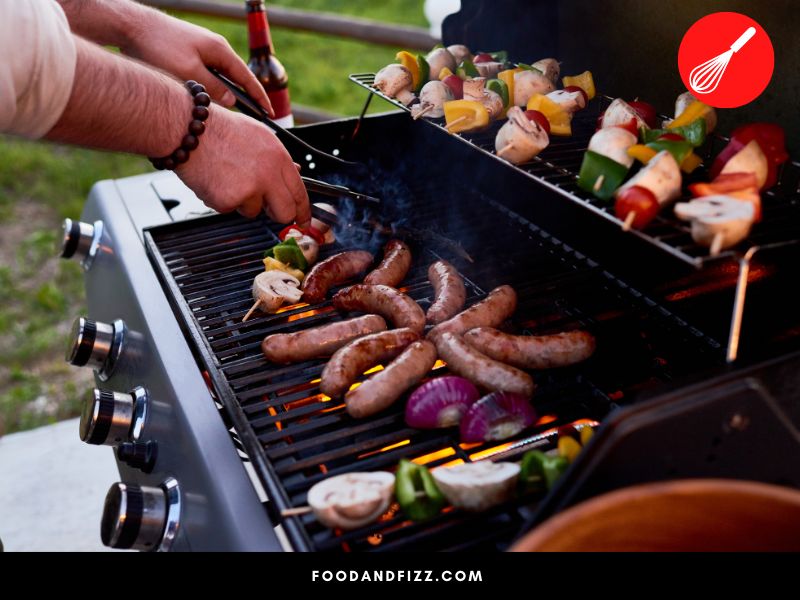
6. Burgers
While delicious when grilled, burgers can also be amazingly delicious when smoked and is something that a novice smoker can pull off with ease.
As we said, meat with higher amounts of fat is more suitable for this cooking method, so it is important to choose the right lean-to-fat ratio for your burgers, or the ratio of lean meat to fat content.
Too lean and you might end up with too-dry burgers. Most cooks recommend an 80-20 ratio for burgers, that is, 80% lean meat to 20% fat to get the right juiciness.
- Recommended Smoker Temperature: 225°F
- Finished Temperature: 160°F
- Smoking Time: 1 hour
- Tips for Success: Choose 80/20 ground beef. Reverse-sear the burgers after smoking to get that crispy crust and exterior.
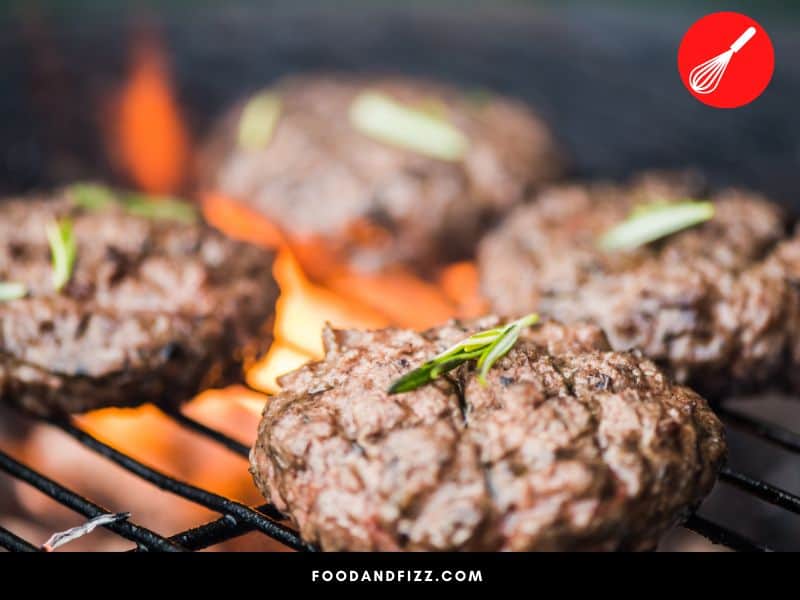
7. Ham
Ham is a processed pork product that is made from a pig’s hind legs. It is a staple breakfast food and also a staple at holiday tables. While ham can usually be found pre-smoked at the stores, you can opt to get them unsmoked if you want to hone your skills with smoking meat.
Ham is typically brined and cured or ready to eat, which offers some advantages to you as a beginner. The brining process makes the meat moist and less prone to drying out, which makes it more forgiving if you’re just starting out.
The flavors and seasonings in the ham also do well with slow and low-heat cooking, and by the end of the process, you’ll end up with something with a depth and richness of flavor.
If you get raw and unprocessed ham (also called green ham), keep in mind that you have to brine it first before smoking.
- Recommended Smoker Temperature: 225°F – 250 °F
- Finished Temperature: 145 °F
- Smoking Time: 1 hour (fully cooked ham) and up to 7 hours (if brined and uncooked)
- Tips for Success: A homemade glaze will elevate the flavor of your smoked ham, and impress your guests. Buying already-brined ham will significantly shorten preparation time.
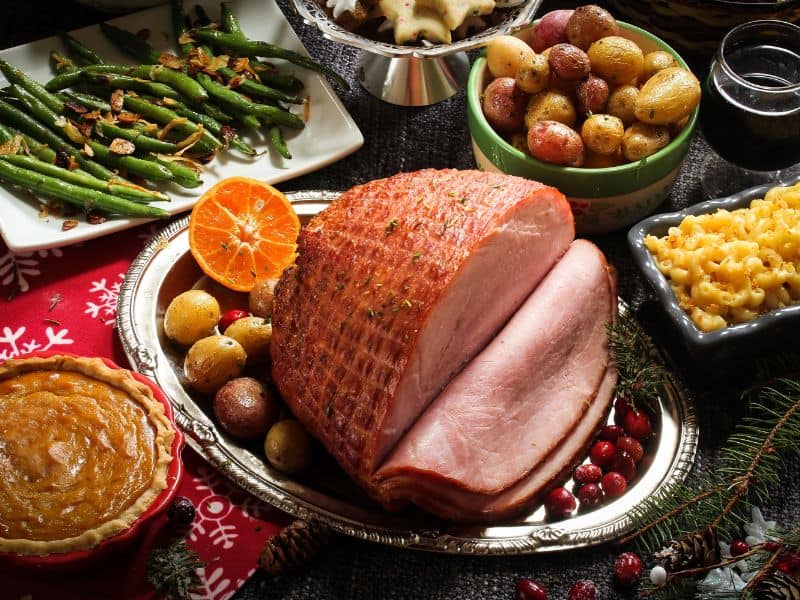
8. Breakfast Fatty
A breakfast fatty is basically a log of your favorite breakfast items such as eggs, hash browns, cheese–whatever you prefer really—wrapped in a layer of ground sausage and then bacon, and then rubbed with seasonings, and coated with barbecue sauce.
It is basically a complete breakfast in a log. It is popular for barbecue parties and tailgating and is also an easy type of meat to smoke for beginners.
- Recommended Smoker Temperature: 225°F – 240°F
- Finished Temperature: 160 °F
- Smoking Time: 1-3 hours, depending on the thickness of the fatty or the fillings
- Tips for Success: Low and slow cooking allows even cooking and allows the bacon covering to render fat and come to a nice crisp. Turning up the heat towards the end of cooking will also help make the exterior crispy.
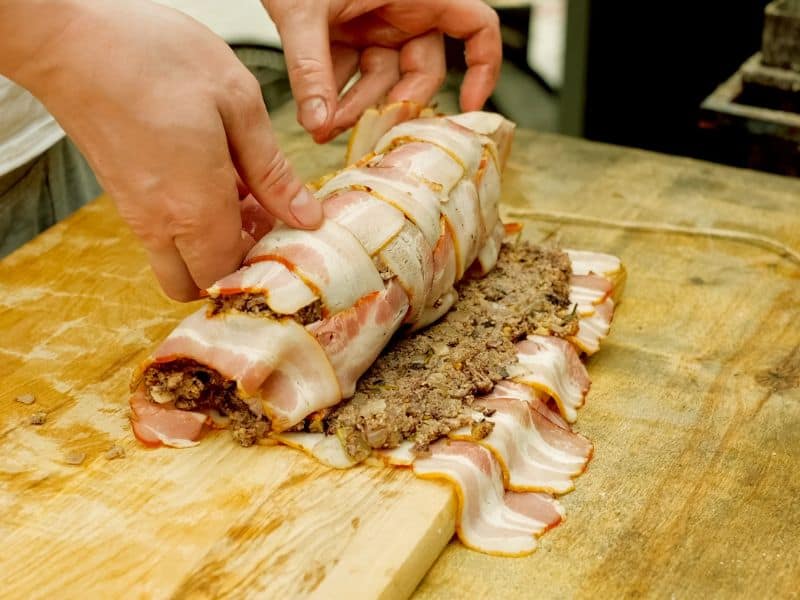
9. Pork Butt (Pulled Pork) or Pork Shoulder
Most expert cooks agree that pork butt or pork shoulder is the meat cut you should start off with if you want to get good with smoking.
This fatty cut of meat is very forgiving, as its high-fat content allows it to retain flavor and moisture throughout the cooking process, something every beginner that’s just starting out will appreciate.
It is also a larger cut of meat that can feed more people while being relatively inexpensive, so it’s perfect to experiment with. It can also help you get started on the process of smoking, from choosing the right kind of meat to all the other intricacies involved in the process.
Plus, if you have some leftovers, you can make some pulled pork sandwiches with the meat, so it’s a win-win situation.
- Recommended Smoker Temperature: 225°F- 240°F
- Finished Temperature: safe at 145°F, but recommended finished temperature is 195-205°F.
- Smoking Time: 1.5 hours per pound, can take 8-10 hours
- Tips for Success: Choosing bone-in meat ensures more flavor and texture. Because this can easily take the whole day, it is best reserved for the weekends.
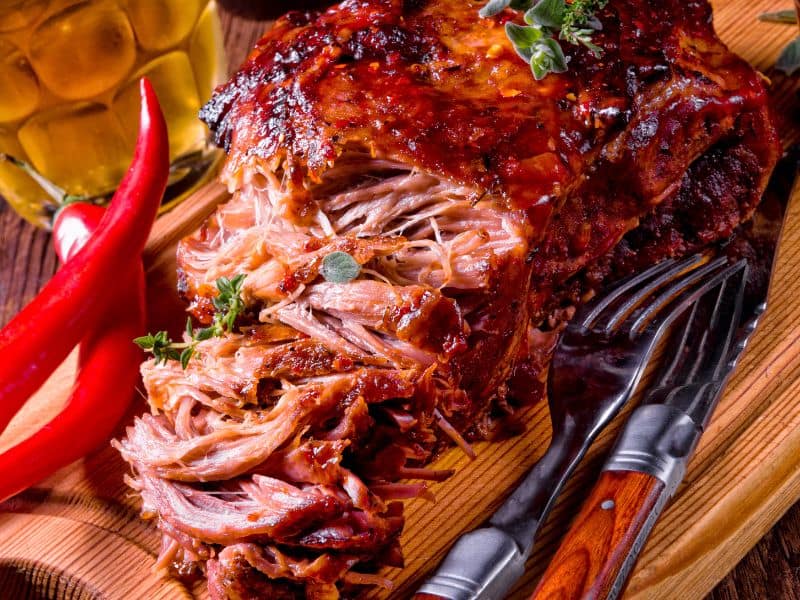
10. Pork Belly or Bacon
Pork belly or bacon is not just for frying, but can also do well with smoking.
The high-fat content in this cut of meat, from the pig’s belly, needs a long, slow smoking time to properly render the fat and allow it to melt into the meat, resulting in something decadent and flavorful. Not allowing enough time or rushing the process can make the fat chewy and unpleasant to eat.
Pork belly may be used as is with just a dry rub, or can be cured and made into traditional bacon first prior to smoking.
- Recommended Smoker Temperature: 200°F
- Finished Temperature: 160°F
- Smoking Time: 3- 4 hours
- Tips for Success: How thick your pork belly is will affect its cooking time so make sure to have an instant-read thermometer that will allow you to monitor the temperatures.You can also make your own cured bacon if you want to ensure that you have full control over the ingredients.
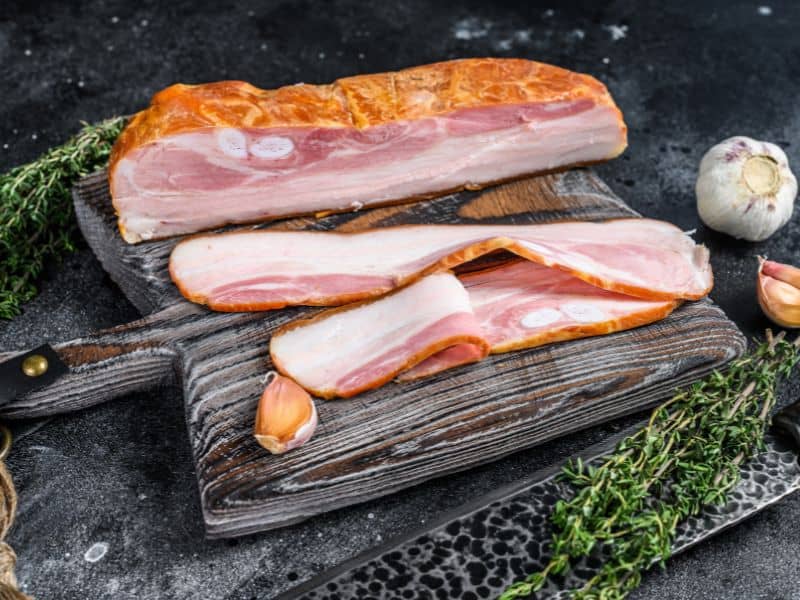
11. Pork Loin
Like chicken breast, pork loin is another cut of meat that does not have a lot of fat content, but when done right, it can successfully and deliciously be cooked through smoking.
Because it has a lower fat content, it also takes less time to smoke than other fattier cuts like pork belly.
- Recommended Smoker Temperature: 225°F – 250°F
- Finished Temperature: 145 °F
- Smoking Time: 4-5 hours
- Tips for Success: Brining pork loin can help tenderize the meat, add flavor and add moisture to prevent it from drying out during smoking.

12. Turkey Breast
Aside from roasting, smoking is another popular way to prepare turkey. Smoking can add interest to the otherwise mild flavor of turkey meat and can give it a depth of flavor.
Also, there’s no need to smoke up a whole turkey every time. You can use the breast and legs if you can get them which takes less time to smoke than a whole bird.
To retain moisture and flavor, always brine your turkey breast first.
- Recommended Smoker Temperature: 275°F – 350 °F
- Finished Temperature: 165°F
- Smoking Time: 4 hours
- Tips for Success: The injection method or a flavored brine ensures that your smoked turkey breast won’t dry out and will be moist and delicious. Bone-in turkey breasts ensure that there is more protection of the meat while smoking to prevent it from drying out.

13. Turkey Legs
Apart from turkey breast, turkey legs also do well with smoking and are also a great option if you want something quicker than cooking a whole bird.
Since turkey legs are dark meat and have more fat than turkey breast, they are also more flavorful and less prone to drying out, which makes them do well with this method. Lightly oiling the skin allows the spice rub to adhere to the skin, and also leads to crispy skin.
Turkey legs are popular in state and county fairs, and many people have a lot of fond memories attached to them. Serving this at your barbecue party will not only be delicious but will be fun as well. Eating turkey legs like a caveman is sure to be a unique experience.
- Recommended Smoker Temperature: 275 °F – 350 °F
- Finished Temperature: 170°F
- Smoking Time: 2 -3 hours
- Tips for Success: Lightly coating with oil and adding baking powder to the spice rub ensures nice browning and a crispier skin.
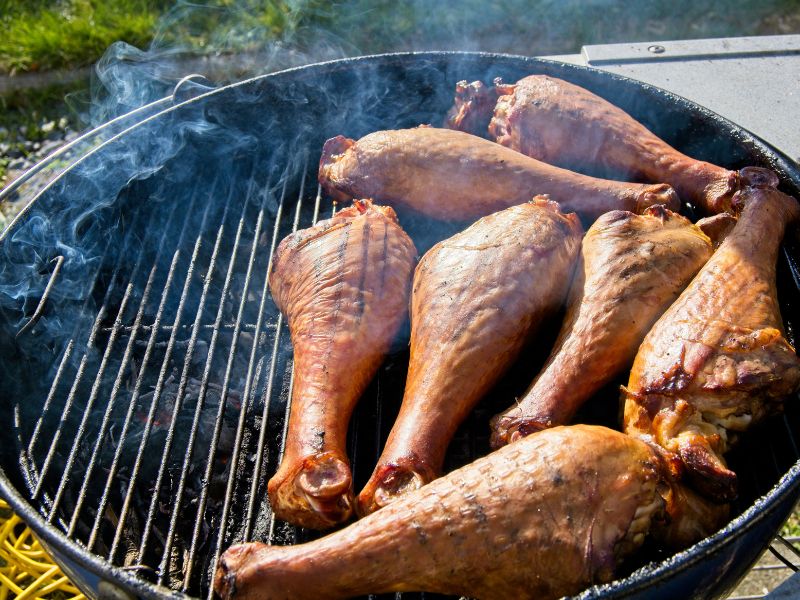
14. Salmon
Smoked salmon can be cold-smoked or hot-smoked. Both are seasoned and cured in seasonings but cold-smoked salmon is typically smoked at lower temperatures, usually below 90°F. This type of smoked salmon is usually sliced thinly, is more delicate, and is usually what you see served with things like bagels.
Hot-smoked salmon, on the other hand, is smoked at higher temperatures and is less delicate than its cold-smoked counterpart. It is advisable to start with hot-smoking salmon as a beginner.
Besides being a source of healthy fats and besides its anti-inflammatory properties, the flavor of salmon is just enhanced and complemented by smoking. Unlike its land animal counterparts, salmon takes only about an hour to smoke, which is something a beginner can easily master.
- Recommended Smoker Temperature: 220°F
- Finished Temperature: 145°F
- Smoking Time: 1 hour
- Tips for Success: Choose skin-on salmon and smoke it with the skin on so it will not fall apart or break apart. Monitor your salmon closely as it can get overcooked easily if not kept in check.

15. Shrimp
If you want to serve something that can be smoked in less than an hour, look no further than shrimp.
Shrimp is one of the most popular types of seafood to consume in the country, and while smoking wouldn’t normally be your first choice for a cooking method for shrimp, it does work and gives it a unique, enjoyable flavor.
If you’re very new to smoking and are just getting the hang of it, shrimp is an excellent meat to start with.
- Recommended Smoker Temperature: 225°F
- Finished Temperature: 120°F
- Smoking Time: 20-30 minutes
- Tips for Success: The cooking time will vary depending on the size of the shrimp. Coating in olive oil or butter helps the spices and seasonings to stick to the shrimp. Peeled shrimp will infuse more of the smoke flavor than shell-on shrimp.
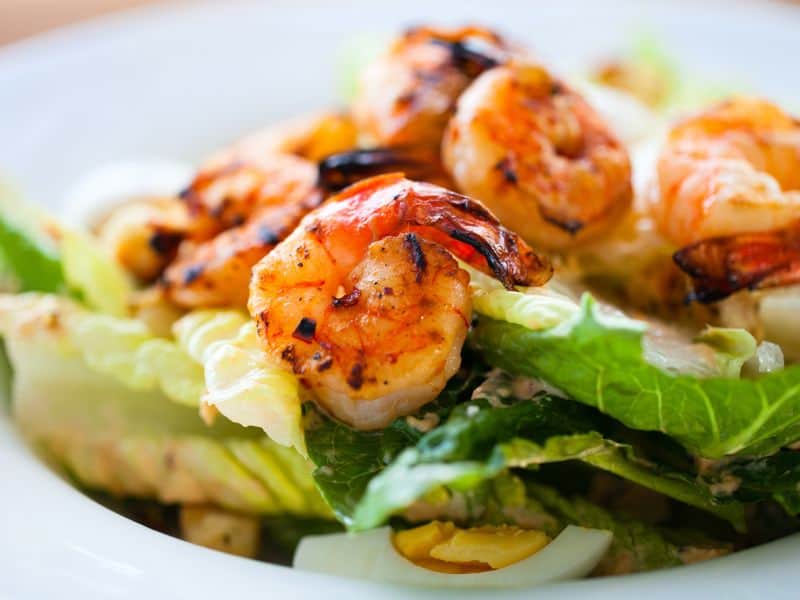
16. Lamb Shoulder
If you enjoy the gamey flavor of lamb, then is a good beginner option if you wanted something a little more upscale to serve than, say, pork.
According to Smoked BBQ source, the thick layer of fat found on lamb shoulder makes it a more forgiving meat to smoke, even if for some reason you left it in the smoker for a little bit too long, making it very beginner-friendly.
- Recommended Smoker Temperature: 225°F – 250°F
- Finished Temperature: 170°F
- Smoking Time: 5 hours
- Tips for Success: Spritzing the lamb shoulder every hour during cooking helps it retain moisture and ensures that it will retain the smoke flavor.
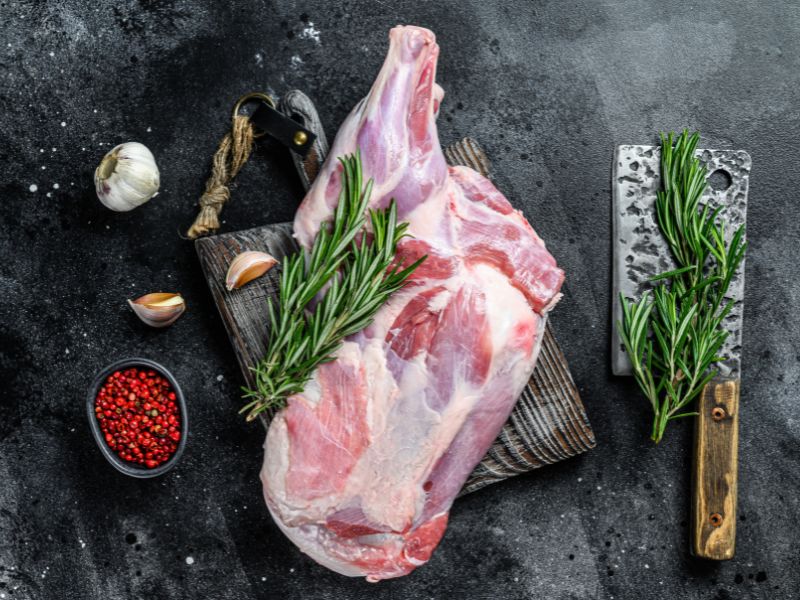
17. Tri Tip
If you want to go the beef route but need something that won’t take too long to smoke, smoked tri-tip is an excellent option. A tri-tip is a cut of meat shaped like a triangle that is taken and cut from a part of the cow called the bottom sirloin.
This is located in front of and below the hip of the cow. It is called as such because of its shape and location, with the tip of the triangle being the edge of the sirloin. It is sometimes called “Santa Maria Steak”.
Tri-tip is extremely beefy and meaty in flavor, but lower in fat compared to other cuts. It is juicy and tender and flavorful, even if it is boneless.
It is somewhat affordable compared to other steak cuts, but unless you live close to a good butcher shop, can also be difficult to find. Smoking is one of the best ways to prepare it although it does do well with other cooking methods.
Unlike brisket which may take literally a whole day to smoke, tri-tip can be done in as little as 2 hours. It is a great alternative for something quick yet still brisket-y in taste.
- Recommended Smoker Temperature: 225°F – 250°F
- Finished Temperature: 130 °F – 140°F
- Smoking Time: 2 to 3 hours
- Tips for Success: For a nice crust and added flavor, try reverse searing on the grill after smoking.
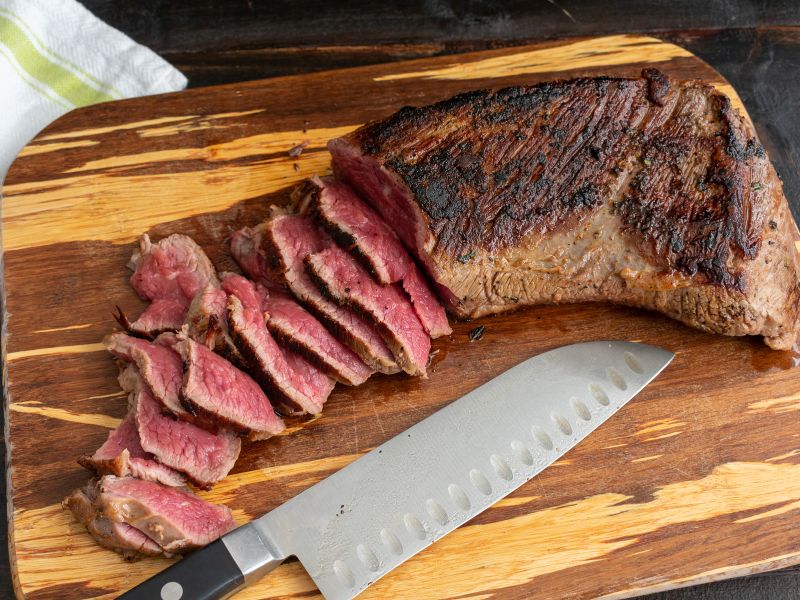
18. Rib Eye Steak
Rib eye steak is one of the most elegant, flavorful and high-quality steak cuts you can get, and is perfect for a special occasion. It is a steak cut taken from the rib of the cow, which isn’t exercised very much so it is especially juicy, flavorful, and tender.
It is one of the most popular steak cuts to smoke due to its high-fat content, which holds up well to smoking.
- Recommended Smoker Temperature: 225°F – 250 F
- Finished Temperature: 135°F (medium)
- Smoking Time: 40-60 minutes, depending on the desired doneness
- Tips for Success: Reverse-searing gives it a nice crust to finish.
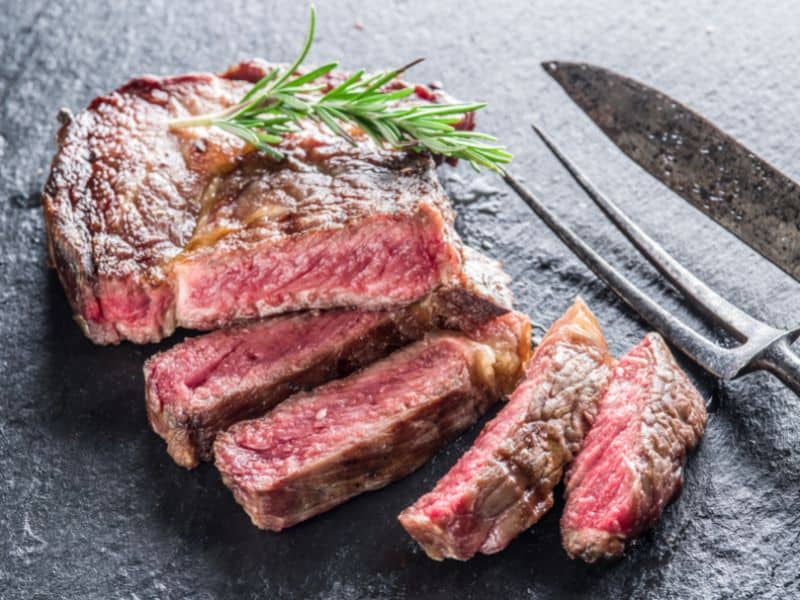
19. Beef Ribs
Beef ribs are taken from the cow’s upper back, the same area where prime rib roast and rib eye steaks are taken from. In fact, the bones in beef ribs are the same ones that are typically attached to these steak cuts.
After the prime rib roast cuts are carved, beef back ribs are typically what’s left over. While the meat in beef ribs may generally be tougher, it is also flavorful as it is very close to the bone.
They can be quite large at 5-8 inches long and is the perfect crowd-pleaser. After smoking for a few hours, the tender meat pulls away from the bones and is a delight to eat with your hands with some delightful barbecue sauce.
- Recommended Smoker Temperature: 225°F – 250°F
- Finished Temperature: 185°F – 195°F
- Smoking Time: 4 to 5 hours
- Tips for Success: Choose back ribs that have some more meat left over in them and are not trimmed too close to the bone. Rubbing oil over the meat prior to applying the spice rub allows it to stick better on the meat.
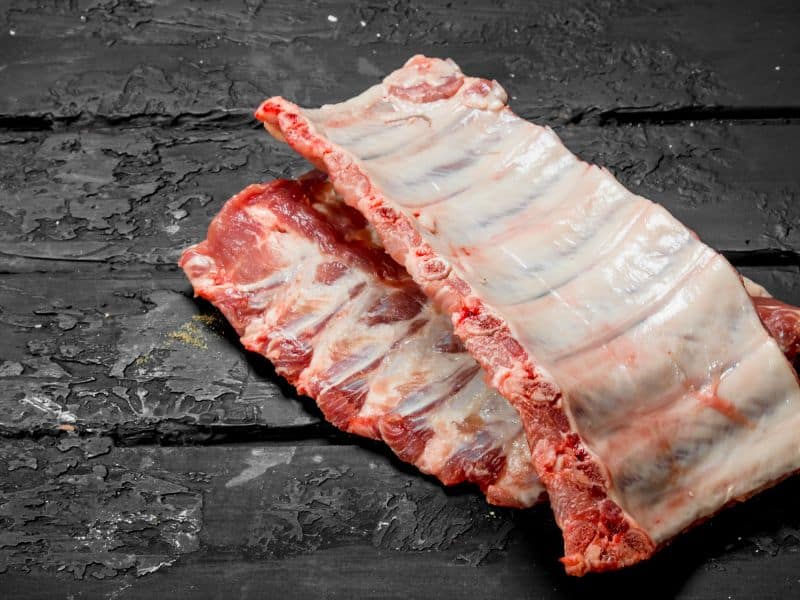
20. Short Ribs
Short ribs are different from beef back ribs in that they are taken from underneath the back ribs, near the front part of the cow.
They have a mixture of both meat and muscle unlike back ribs and have a higher meat-to-bone ratio. They also have a layer of meat as well as a layer of fat on top of the bones.
They are also shorter in size than back ribs, typically about 3-6 inches in length.
- Recommended Smoker Temperature: 225°F – 250°F
- Finished Temperature: 195°F – 200°F
- Smoking Time: 6 to 8 hours
- Tips for Success: Pay attention to the internal temperature. When overcooked, this type of cut can become dry, chewy, and unpleasant to eat.
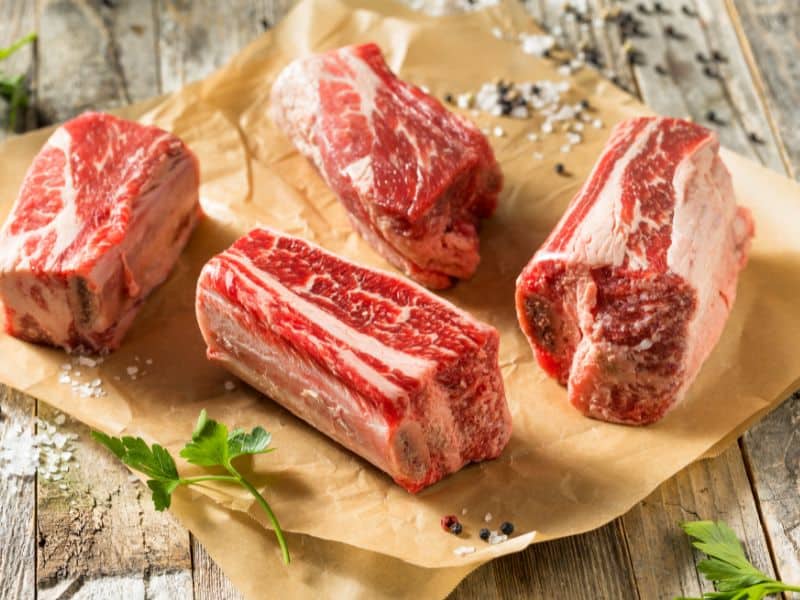
21. Chuck Roast
Chuck roast is a cut taken from the shoulder of the cow. This is a part that is often used by the cow, which means that it has more muscle and connective tissue.
It is a tough meat that does well with long cooking methods like smoking, where cooking at lower temperatures for a long period of time can make the meat more tender and more flavorful.
It is also inexpensive compared to other meat cuts, but can taste just as good as the more expensive ones when properly cooked.
Admittedly this isn’t one of the quick smoking meats but if you’re willing to dive in and invest in the time and effort, I’m pretty sure it’s totally worth it.
- Recommended Smoker Temperature: 225°F – 250°F
- Finished Temperature: 200°F
- Smoking Time: 12 to 20 hours
- Tips for Success: Chuck roast tends to dry out easily, so delay slicing until just before serving. Also, slice only what you need. Leftovers can be used for things like pulled beef.
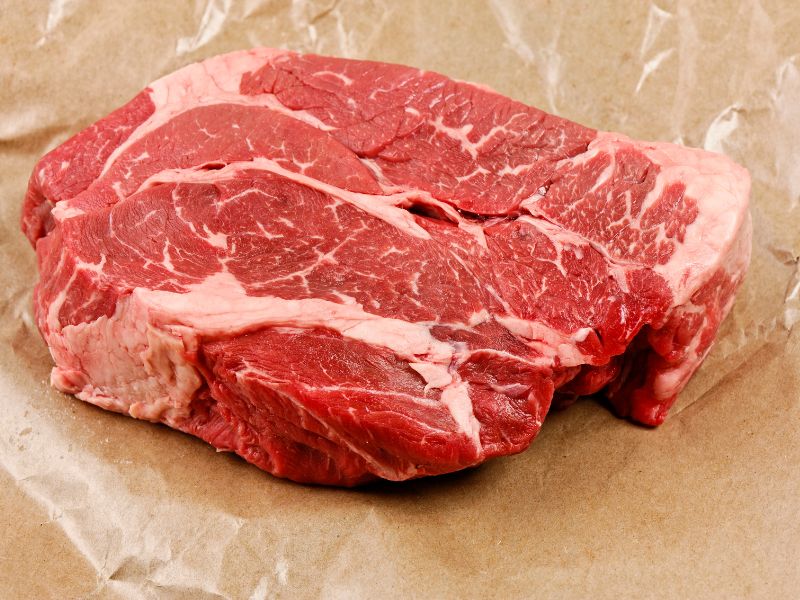
Bonus Meat: Brisket
Okay, so most experts agree that brisket isn’t really the first meat you should reach for when you’re new to smoking as it takes somewhat of a knowledgeable touch to get this one just right.
However, I think it’s best to include it in this so that as a beginner smoker, we know what to reach for.
Brisket is known as the King of BBQ, and it really is what you’re aiming for if you’re an aspiring pitmaster. A brisket is a large cut of beef that comes from the chest part of the cow, or its pectoral muscles.
It is a part that the animal uses a lot, therefore it is full of muscle and connective tissue, making it quite tough unless subjected to a long cooking process like smoking.
Since it is quite limited (there are only two cuts per cow), it can be quite expensive, and therefore not really ideal to practice on if you’re just starting to hone your skills.
Aside from that, it also takes a long time to prepare from start to finish, often overnight preparation. It also requires considerable knowledge on time, temperature, and the nature of meat, in order for the brisket to be properly and deliciously cooked.
It is best to practice on other cuts of meat and gradually work your way up to it over time, however, it is also useful to know that we have something challenging and interesting to look forward to in our journey.
- Recommended Smoker Temperature: 225°F – 250°F
- Finished Temperature: 190°F – 205°F
- Smoking Time: 12 to 20 hours
- Tips for Success: Not the easiest meat to smoke, but practicing with other beef cuts will ensure better success
Conclusion to 21 Easiest Meats to Smoke for Beginners
In general, the easiest meats to smoke for beginners are meats with higher fat content and more connective tissue, those that are not too big and don’t take too long to smoke, are affordable, and are easy to find.
There are many different meat options to choose from if you are just beginning your journey with smoking meat. From whole chicken to chicken breast, wings and thighs, to turkey, to pork shoulder and even pork belly, to breakfast staples like ham, sausage, and bacon, to seafood like salmon and shrimp, and to more forgiving cuts of beef like ribs and steaks.
Practicing with these cuts of meat while you get to know your smoker and gain knowledge about the intricacies of the smoking process can help equip you with the right skill and knowledge needed to tackle the bigger, more complex types of meat to smoke, such as the famous brisket.
As with anything, you have to start somewhere if you wish to develop the needed skills to become a truly knowledgeable pitmaster.


[…] oral clindamycin[…]
oral clindamycin